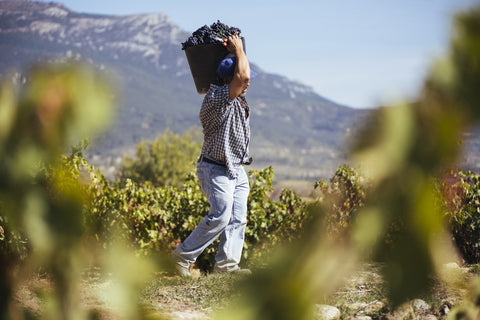D.O.Ca Rioja in a Nutshell
Rioja is one of the oldest and most famous Spanish wine regions. Wine was already made in the area by the Ancient Romans and after the Reconquista (711–1492) there was renewed and increased development in winemaking led by the monasteries .
The biggest boost was brought about by the decimation of the Bordeaux vineyards by powdery mildew and the grape louse (Phylloxera) in the second half of the nineteenth century. French envoys came to Rioja to look for wine, up to 50 million litres per month! Around 1900 the region suffered a Phylloxera infestation of its own. Then came the Civil War, followed by the Second World War. There wasn't a revival of viticulture until the 1960s and 1970s. This was subsequently reinforced by Spain's accession to the EEC in 1986. In 1925, Rioja was the first to be awarded the D.O. (Denominaciòn de Origen) classification and in 1991, it was the first to be named a D.O.Ca (D.O. Calificada).

Alavesa, Alta and Oriental
Rioja is located in the Ebro valley, some 100 kilometres south of the triangle formed by Bilbao, San Sebastian and the Atlantic coast. Despite the relative proximity of the sea, it doesn't really have a maritime climate: a mountain range to the north shields the area from the cooler, rainier Atlantic weather. It can be divided into three parts: Rioja Alavesa and Rioja Alta to the west and Rioja Baja, also known as Rioja Oriental to the east.
Alta and Alavesa form the Rioja plateau, 400 to 500 metres above sea level. The climate is somewhat cooler and the soil is blessed with clay, chalk and sand stone. This is where the finer wines are made, fresher and more elegant than the stronger and more alcoholic wines of the rather warmer and drier Rioja Oriental, where Garnacha prevails. Nevertheless, the local microclimates play a determining role in the quality of the wines and you can also find some amazingly good wines in Rioja Oriental.

The Grapes
The principal grape is Tempranillo, a grape which thrives in the relatively cooler Alta and Alavesa. It is a grape which ripens early and is fairly resistant to oxidisation. Because it evolves relatively fast, it is often blended with other grape varieties from the region. The most important of these are Garnacha, Mazuelo (Cariñena) and Graciano. Many blends are made with three or four of these varieties. Tempranillo represents elegance and fruitiness; Garnacha boldness and alcohol; Mazuelo colour and tannins; and Graciano freshness and refined aromas. Sometimes even Viura (Macabeo, i.e. a white grape!) is added to make these wines more accessible.
Typically, Rioja is aged in 225 litre Bordeaux barrels. Until a few years ago, American oak was mostly used for this because it lends the wine more outspoken vanilla tones. Nowadays, more and more French oak is used with its characteristic gentler and more noble aromas.
Versatile Wines
Depending on vinification and ageing, Rioja produces a versatile pallet of red wines, ranging from modern, smooth, fruity wines to particularly complex, velvety, sometimes powerful Crianzas and Reservas. There is also a new trend, introduced by a few progressive bodegas and winemakers: the Vino de Autor, signature wines that often do not adhere to the guidelines of the Consejo Regulador. An interesting trend that we are following carefully.
Furthermore, the Consejo itself has made some changes in the pursuit of a more terroir-driven viticulture and monocépage wines. A circle system has been created with four concentric rings. Generic Rioja wines belong to the outermost ring, while the innermost ring is reserved for 'Viñedo Singular', a specific piece of vineyard at least 35 years old where even stricter rules apply to viticulture and production: these are known as 'single vineyard wines'. Between them are two other levels: 'Vino de zona', the three classic regions (Alta, Alavesa and Oriental), and 'Vino de Municipio', at the level of the various villages and towns (about 140 of them).

White and Rosé Wines
Don't forget: white wines are also made in Rioja. The most important grapes for these are Viura, Garnacha Blanca en Malvasia. Those that aren't aged in wood are fresher, while the wood-aged ones are full-bodied and more mature wines that can be cellared. The previously little-used Tempranillo Blanco is a newcomer with great potential. Verdejo, Sauvignon Blanc and Chardonnay have all been recognised as grape varieties in Rioja since 2007. Tempranillo is typically used for rosé although a number local grapes have made some inroads over the last few years. Maturana Tinta and Maturana Blanca, Monastel, Torrontés, ...
For a more in-depth analysis of the Tempranillo grape and the meaning of terms like Crianza or Reserva, we'd like to point you in the direction or our upcoming blogs posts.
Our Rioja bodegas: